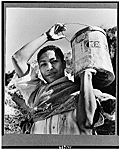| Contents:
Early Relations and the Question of Fascism 1939 -- The Breakthrough Year: Putting Suspicion to Bed Materials and the Development of Brazilian Industry |

Industrial Growth
The development of industry was not only one of Getulio Vargas' goals
upon entering office, but it was a goal of American officials who sought
to make Brazil a more efficient contributor to the war effort. Prior to
the mid-late 1930's the economy of Brazil was heavily dependent upon one
product. The first product, upon colonization, was brazilwood, and it was
exported to Portugal for the extraction of dye. After brazilwood the product
became sugar, and following sugar came gold and silver. The final economic
cycle was coffee, and that brought Brazil into the 20th century. Up until
World War II the major export of Brazil was coffee, with its compliment
sugar at a close second. The American government sought to move Brazil
from this one crop economy to a semi-industrialized state that could export
processed materials, using their own raw
materials at home. This was a vision of Getulio Vargas as well. Unfortunately,
industry in Brazil did not really take off until Kubitschek became president.
The United States War Production Board vested interest in an industrialized
Brazil for the primary exports of rubber and manganese.
Material Exportation
Brazilian rubber
was exported all over the world in huge quantities. It was farmed in the
 |
Amazon Basin, possibly the largest supply of natural rubber in the world. To this day there are workers who tap the trees of the Amazon rain forest. All the rubber plants in the far east were in the hands of the Japanese, thus the Allied powers had only one option, and that was to get rubber from Brazil. Roosevelt established the Rubber Reserve Company, a byproduct of the Reconstruction Finance Corporation. At home, Vargas established the Rubber Credit Bank, which was created to "buy crude rubber." Rubber production rose greatly with the outset of World War II, but it was not up to American expectations. The projected tonnage for 1943 was 35,000, and the Brazilians only produced 22,000 tons. Growing considerably over the next couple of years, rubber production reached 28,000 tons in 1944 and 40,000 tons in 1945. Brazilian workers most likely fell short of the established goals because of slave labor conditions on rubber farms. A lack of organization also resulted in lower production volumes. Manganese was also exported to the Allied powers.